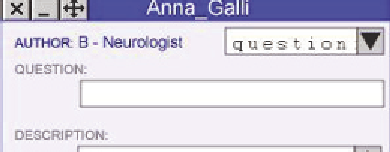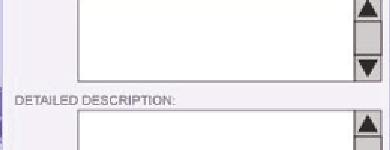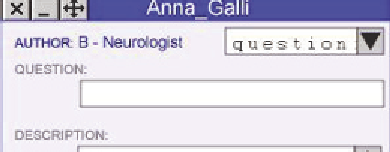Information Technology Reference
In-Depth Information
Figure 8. An example of consulting window for
the neuro-radiologist who is answering to the
neurologist's request
support communication and collaboration within
the interdisciplinary team: such techniques move
from just system descriptions to collaborative
construction of mock-ups, cooperative prototyp-
ing, and game-like design sessions. Most of these
techniques use fantasy and imagined futures to
study specific actions rather than just analyze solu-
tions after setting up goals (Bødker, Grønbæk, &
Kyng, 1993). In Greenbaum and Kyng (1991), the
Future Workshop technique is discussed: it fore-
sees group meetings run by at least two facilitators
with the aim of analyzing common problematic
situations, generating visions about the future,
and discussing how to realize these visions. In
our approach, the term “workshop” is used with
a different meaning provided in every English
dictionary: for example, “a small establishment
where manufacturing or handicrafts are carried”
(Merrian-Webster online, www.m-w.com). We
speak about “Software Shaping Workshops”, re-
ferring to software environments that enable users
to “shape” virtual tools and data. In other words,
the real workshop is the metaphor we adopt for the
conceptual model of our software environments.
Participatory design of visual interactive systems
is performed through the interaction with SSWs
customized to the needs, preferences, habits, and
capabilities of each specific community of users
belonging to the interdisciplinary team. A simi-
lar approach in participatory design literature is
Cooperative Prototyping (Bødker & Grønbæk,
1991), in which prototyping is viewed like a co-
operative activity between users and designers.
Prototypes are developed by software engineers,
then discussed with users, and possibly experi-
enced by them in work-like situations. Prototype
modifications may be immediately made by direct
manipulation, also by users, during each session
of participatory design. However, in such an ap-
proach, prototypes just represent an interactive
digital evolution of chapter-based mock-ups: real
systems are then reprogrammed, and all modi-
fications require large programming efforts that
are postponed and made by designers after each
other analogous cases?
other analogous cases?
hypothalamic hamartoma,
agenesis of corpus callosum,
arachnoid cyst
hypothalamic hamartoma,
agenesis of corpus callosum,
arachnoid cyst
5 years old with precocious
puberty since 4 years
5 years old with precocious
puberty since 4 years
reference to a similar case
reference to a similar case
a similar case is discussed in |
a similar case is discussed in |
to develop software applications in support of
organizational tasks (Brancheau & Brown, 1993).
The organization in which such people work
requires them to perform end-user computing
and to assume the responsibility of the results of
this activity. Indeed, one fundamental challenge
is to develop environments that allow people
without a particular background in programming
to develop and tailor their own applications. In
this line, the EUD-Net collaboration preferred
the term end-user development to indicate the
active participation of end users in the software
development process.
Traditional participatory design approaches
exploit techniques derived from social theories that











Search WWH ::

Custom Search